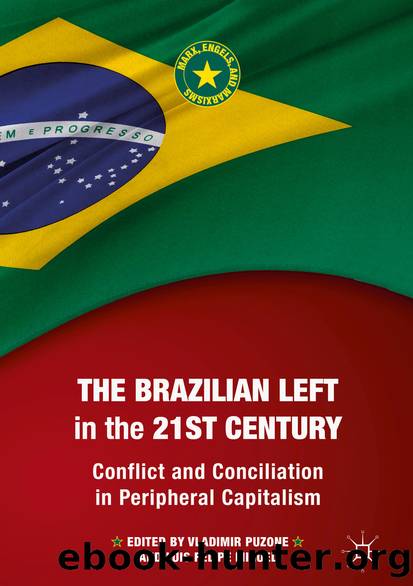The Brazilian Left in the 21st Century by Unknown

Author:Unknown
Language: eng
Format: epub
ISBN: 9783030032883
Publisher: Springer International Publishing
Feminist Movements and the Making of Democracy, 1980s
The masculine character of politics in Brazil certainly endures, but underrepresentation should not be confused with an absence of political action. A closer look reveals a more complex situation and electoral politics could be misleading in understanding womenâs engagement in politics in Brazil (Pinto 2003). Political participation does not occur despite underrepresentation, but in a context of imbalanced influence. That also does not imply an absence of political effect, although it means that feminist agenda was kept within rigid limitsâthat have been certainly pressed by feminist movements, as is discussed later.
Politically organized in the face of the dictatorship inaugurated with the 1964 coup and its restrictions on political participation, feminist movements valued autonomy and mistrusted a transition that preserved a central position for the civil elites from the regime. At the same time, many feminists already acted within the scope of center-left parties and saw the new regimeâs institutionalization as an opportunity to âengenderâ Brazilian democracy (Alvarez 1990).
The themes that had priority in their political engagement at the time were violence against women and womenâs health, due to the importance they had on the movementâs agenda, but also because there was not a strong resistance to them among parties and politicians, creating a possibility to have allies among parties and recently elected state and municipal governments in the transition process. It is important to keep in mind, though, that even these themes had to be pushed into democratic debate and the stateâs arena, a role that was assumed by feminist women and movements at the time (Pinto 2003; Teles 2017). The creation of police stations focused on womenâs needs and complaints, starting in 1985, was a direct consequence of the activism that created public campaigns that spread significantly at the time (Bandeira 2009). At the same period, the creation of focused public health policy with a comprehensive approach, the Programa Integral de Assistência à Saúde da Mulher (the Comprehensive Program for Womenâs HealthcareâPAISM), in 1983, was the starting point for achievements and disputes in the following decades.
Significant efforts to build political institutions focused on womenâs needs and interests also took place in the 1980s. Councils for womenâs rights were created at local, state, and national levels. The National Council for Womenâs Rights (CNDM), created in 1985, would lead the political lobby for womenâs rights in the Constituent Assembly, in a process that exemplifies the relationship that was then established between feminist movements, political parties, and the state. Although women were only 5% of the elected for the Assembly, their organization produced important results. In addition to the achievement of equal constitutional status for men and women, they were also responsible for constitutional amendments prohibiting wage differentials due to sex, age, skin color, or marital status; making maternity and paternity leaves mandatory; including rural workers in Social Security; guaranteeing the right for female prisoners to keep their children during the breast-feeding period; and guaranteeing equal property rights for women regardless of their marital status.
It
Download
This site does not store any files on its server. We only index and link to content provided by other sites. Please contact the content providers to delete copyright contents if any and email us, we'll remove relevant links or contents immediately.
What's Done in Darkness by Kayla Perrin(25500)
Shot Through the Heart: DI Grace Fisher 2 by Isabelle Grey(18219)
Shot Through the Heart by Mercy Celeste(18160)
The Fifty Shades Trilogy & Grey by E L James(17774)
The 3rd Cycle of the Betrayed Series Collection: Extremely Controversial Historical Thrillers (Betrayed Series Boxed set) by McCray Carolyn(13189)
The Subtle Art of Not Giving a F*ck by Mark Manson(12912)
Scorched Earth by Nick Kyme(11832)
Stepbrother Stories 2 - 21 Taboo Story Collection (Brother Sister Stepbrother Stepsister Taboo Pseudo Incest Family Virgin Creampie Pregnant Forced Pregnancy Breeding) by Roxi Harding(11040)
Drei Generationen auf dem Jakobsweg by Stein Pia(10217)
Suna by Ziefle Pia(10186)
Scythe by Neal Shusterman(9259)
International Relations from the Global South; Worlds of Difference; First Edition by Arlene B. Tickner & Karen Smith(8608)
Successful Proposal Strategies for Small Businesses: Using Knowledge Management ot Win Govenment, Private Sector, and International Contracts 3rd Edition by Robert Frey(8419)
This is Going to Hurt by Adam Kay(7695)
Dirty Filthy Fix: A Fixed Trilogy Novella by Laurelin Paige(6453)
He Loves Me...KNOT by RC Boldt(5804)
How to Make Love to a Negro Without Getting Tired by Dany LaFerrière(5378)
Interdimensional Brothel by F4U(5304)
Thankful For Her by Alexa Riley(5161)
